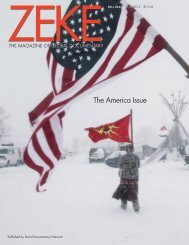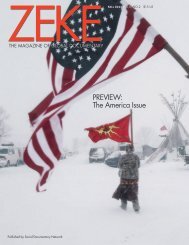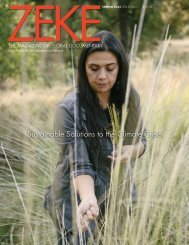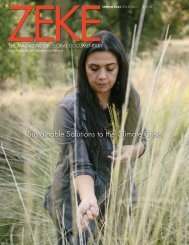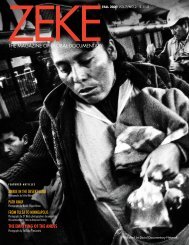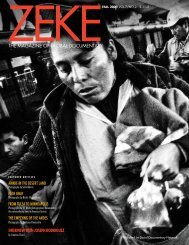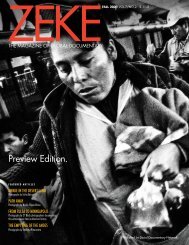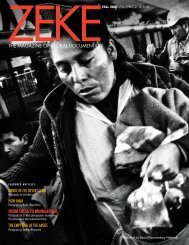ZEKE Fall 2019
Contents includes: "Youth of Belfast" by Toby Binder, and "Delta Hill Riders" by Rory Doyle, winners of ZEKE Award for Documentary Photography "Rising Tides" with photographs by Sean Gallagher, Lauren Owens Lambert, and Michael O. Snyder "Out of the Shadows: Shamed Teen Mothers of Rwanda" by Carol Allen Storey Interview with Lekgetho Makola, Head of Market Photo Workshop, South Africa, by Caterina Clerici "Why Good Pictures of Bad Things Matter" by Glenn Ruga Book Reviews and more...
Contents includes:
"Youth of Belfast" by Toby Binder, and "Delta Hill Riders" by Rory Doyle, winners of ZEKE Award for Documentary Photography
"Rising Tides" with photographs by Sean Gallagher, Lauren Owens Lambert, and Michael O. Snyder
"Out of the Shadows: Shamed Teen Mothers of Rwanda" by Carol Allen Storey
Interview with Lekgetho Makola, Head of Market Photo Workshop, South Africa, by Caterina Clerici
"Why Good Pictures of Bad Things Matter" by Glenn Ruga
Book Reviews and more...
- No tags were found...
You also want an ePaper? Increase the reach of your titles
YUMPU automatically turns print PDFs into web optimized ePapers that Google loves.
crux of his argument, is “We aren’t talking<br />
about a faceless disease or an industrial<br />
material—we’re talking about human lives.”<br />
The question I am left with: Does<br />
this book bring more to our understanding<br />
of asbestos and of its victims than a<br />
traditionally-bound photo book with large<br />
photos by the photographer, an essay by a<br />
renowned expert, and a statement by the<br />
photographer?<br />
I think not. I think of another book that<br />
has explored disease of the human body<br />
-— Nick Nixon’s People with Aids (David<br />
R. Godine, 1991) — because in both<br />
cases the subjects are mostly men at late<br />
stages of their lives with loved ones nearby.<br />
Nixon plays no tricks with his book. He is<br />
confident that the stuff within his rectangles<br />
are what matters and that he is a virtuoso<br />
in his compositions. Nixon also has no<br />
qualms understanding that his images are<br />
less important than the people he photographs,<br />
and that the disease is bigger than<br />
both. Palu’s endpoint is the same, but in<br />
A Field Guide to Asbestos, he display less<br />
confidence that his photographs will get<br />
us there. Instead he explores other visual<br />
devices, goes into tangents, and leaves us<br />
with something that has the questionable<br />
authority of a pamphlet, or in this case, a<br />
field guide.<br />
This is not to say the book design is not<br />
important. But as the margins are pushed,<br />
the risks are increased. Few photo books<br />
today are as traditional as Nick Nixon’s<br />
People with Aids, but most skew closer to<br />
thoughtful use of traditional book design<br />
elements of size, scale, paper stock, and<br />
typography. In Palu’s case, he reaches by<br />
re-inventing the concept. This isn’t a book,<br />
it is a field guide. But where are the Jackin-the-Pulpits<br />
and Ruby Throated Sparrows?<br />
There is only one technical illustration<br />
showing how lungs are affected by asbestos<br />
particles credited to Stanford School of<br />
Medicine, and one canned definition of the<br />
type you might find in a field guide titled<br />
“Asbestos-Related Diseases” by the Centers<br />
for Disease Control.<br />
I commend Palu for experimenting with<br />
the boundaries of the photo book and<br />
exploring how to make a photograph more<br />
meaningful and politically affective than<br />
what it usually can do. I am just at a loss<br />
because I know what a good photographer<br />
he is I and I have more faith in the<br />
power of those rectangles than he allows<br />
us with this book.<br />
—Glenn Ruga<br />
CASPIAN: THE ELEMENTS<br />
Photographs by Chloe Dewe<br />
Mathews, Essays by Morad<br />
Montazami, Sean O’Hagan, and<br />
Arnold van Bruggen<br />
Co-published by Aperture and Peabody<br />
Museum Press, 2018<br />
216 pages | $65<br />
In Caspian:<br />
The Elements,<br />
British photographer<br />
Chloe Dewe<br />
Mathews offers her<br />
five-year encounter<br />
with the five countries<br />
bordering the<br />
Caspian Sea: Iran,<br />
Russia, Azerbaijan,<br />
Turkmenistan and Kazakhstan. She<br />
selects her pictures based on the elements:<br />
fire, earth, air, and water. The first<br />
chapter in this systematic approach is<br />
titled “Oil Gas Fire.” Her story begins in<br />
the sanatoriums of Naftalan, Azerbaijan<br />
where individuals are seen resting in tubs<br />
filled with “miracle oil.” Azeris believe<br />
that soaking in this thick crude oil is<br />
medicinal. The abundance of black crude<br />
oil gives the countries of this region their<br />
geopolitical and economic heft.<br />
Mathews moves on from crude oil<br />
therapy to witness Zoroastrian fire rituals in<br />
Iran. Her continuing revelation of Caspian<br />
life and culture loses some momentum<br />
when she focuses on oil production in<br />
Azerbaijan, the industrial component of<br />
her natural elements theme. These images<br />
are not as beguiling as jumping through<br />
fire, yet they express her articulate clarity<br />
of vision. The photographer regains her<br />
storytelling momentum later in the chapter<br />
when she memorably documents Uzbek<br />
cemetery workers in Kazakhstan building<br />
mausoleums for the rich and dying.<br />
In the second chapter, “Rock Salt<br />
Uranium,” she explores underground<br />
mosques in Kazakhstan, travels with<br />
shamans to sacred sites in Azerbaijan and<br />
visits sulfur and salt lakes in Turkmenistan<br />
and Russia respectively. The most incredible<br />
pictures are of radioactive hot springs in<br />
Ramsar, Iran. Mathews could have ended<br />
the book here, where radioactive spas seem<br />
to pulsate on the page, but she has yet to<br />
portray the final element of her story.<br />
“Water,” the closing chapter, is a<br />
bucolic thank you to the Caspian Sea for<br />
all it has revealed to her. The highlight of<br />
this last chapter is her pictures of the Volga<br />
River and Delta where Russians live and<br />
play with a passion best observed when<br />
they are swimming and fishing in icy holes<br />
on great frozen expanses.<br />
Chloe Dewe Mathews’ one hundred<br />
plus visual studies of beauty and grace<br />
amount to a substantial achievement.<br />
Caspian also includes three insightful<br />
essays starting with Sean O’Hagan’s commentary,<br />
which was recently excerpted<br />
in The New Yorker. O’Hagan talks about<br />
Mathews’ “metaphorical documentary<br />
photography” stimulating his childhood<br />
memories. This is a result that many<br />
photographers aspire to. Mathews succeeds<br />
through her desire to search out the<br />
metaphysical as well as the physical in her<br />
Caspian world.<br />
—Frank Ward<br />
58 / <strong>ZEKE</strong> FALL <strong>2019</strong>









